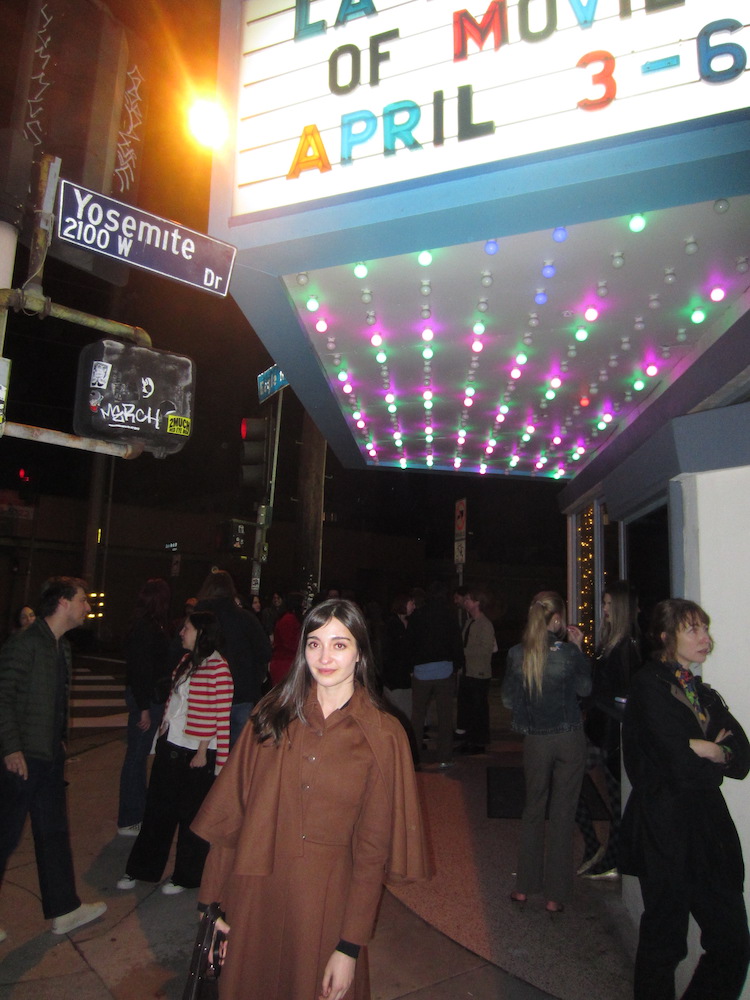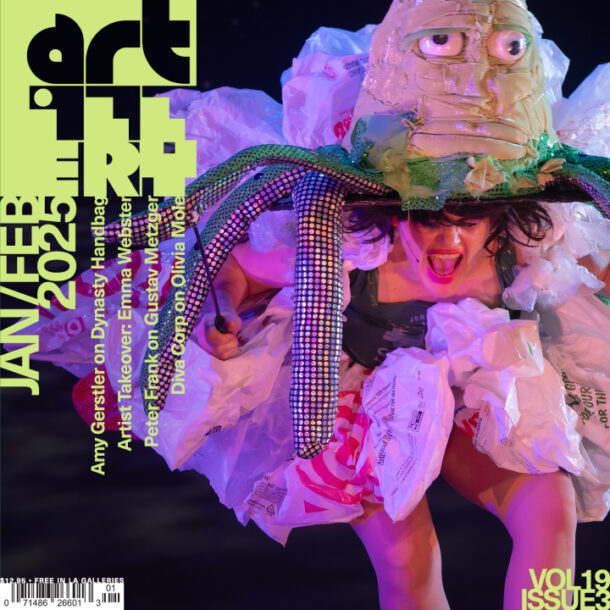DAY ONE
Last night, Vidiots at Eagle Rock saw the start of the only weekend of the year where being an indie filmmaker in LA feels like it truly matters as much as it should. As the second edition of the Los Angeles Festival of Movies kicked off, current microbudget stalwart actor Colin Burgess remarked it “probably has one of the best festival names out there right now, because most festivals are doing ‘film festival’ with the abbreviated FF and not FM, of movies.” Of course, he loves the FM and how it reminds him of that other festival about books. Opening the festival was Amalia Ulman’s Magic Farm, an incredibly of-the-moment satire about a group of clueless Vice-style American journalists led by Chloe Sevigny, who mistakenly enter an Argentinian town in the hopes of finding a local musician, only to stumble through increasingly absurd scenarios of fabricated cultural phenomenon and a brewing health crisis they remain ignorant of, all done using a mixed media visual style that can sometimes be described as “Instagram Reels Realism.” After the screening, I bumped into Jake Thiessen, who produces social media video content for a shoe company and for whom the film’s depiction of the exploitation of the attention economy resonated deeply. Regarding the editing of said shoe commercials, “You gotta get their attention for 2 to 3 seconds and build sentences together to get to the point of what people are saying,” says Thiessen, which wasn’t far off from what happened in the film.
Luckily, I got Amalia Ulman’s attention for more than 2 to 3 seconds and briefly chatted about the formal quirks of her filmmaking practice. Coming from a fine arts background, Ulman spoke about how she approaches cinema with a higher degree of freedom regarding working without certain expectations of decorum. Her film deploys a whole host of 360 cameras and GoPros, weaving in digital textures that we typically associate with online content. Ulman’s approach to shooting was so unorthodox that she specifically hired someone to strap cameras onto dogs; footage she remarks she “had to shoot during lunch time, moments that were not officially part of the schedule, even though, in my mind, it was a very important part of the film.” To Ulman, these different cameras are not quite deployed to impede on what we typically consider cinematic but open up a whole host of visual possibilities that emerge when using them as part of your palette. As she remarked, “There are so many wonderful things that you see online, so dynamic. And then you go watch most indie films at Sundance, and they’re all, like, boring.” In Ulman’s embrace of new technology, which captures images without the sheen of perfection, I was reminded of the rough expressionism of post-millennium Japanese cinema, of films like Hideaki Anno’s Love & Pop (1998) and Katsuhito Ishii’s The Taste of Tea (2004) both of which were shot on early DV. It was the mention of Ishii’s film—which, because of its offbeat rhythm and similar weaving of a large ensemble, I stated was the only other film that reminded me of Magic Farm—that made Ulman light up. As someone who grew up at the turn of the millennium, Ulman reflected on the formal experimentation latent to the films she viewed in her youth: Heisei-era Japanese films and Dogme 95—periods of unrestricted discovery and expression that we now take for granted in an indie landscape consumed by a desire for polish, production value, and respectability.
When posed with the question of whether the effort to make a film feel modern by borrowing from the aesthetics of the internet would always make cinema feel second fiddle to content experienced online, Ulman traced her influences further back to the dawn of cinema. “I think that is not just about the quality of the image. But trying to make something beautiful out of it instead of just trying to be trendy,” Ulman said. “Instead of being hyper-modern, I also pay a lot of attention to really, really, really old films. Like for El Planeta, a lot of the weird close-ups and all that stuff. That’s taken from Silent films, right? But because it’s taken out of context, it feels like something new. And I love doing things like that.”
It appeared that pockets of cinematic innovation, whether in the 20s or the early 2000s, swirl around Ulman’s mind and in Magic Farm. In the movie, there’s a wonderful moment where you see each actor’s head superimposed over a field, captured in an iris with soft edges. I thought of all the young Asian women with permed hair and winning smiles adrift within Korean karaoke videos, but Ulman’s inspiration, Abel Gance’s Napoleon (1927), was far more profound. It was a formal choice that speaks to how refreshing it is to view a contemporary film whose visual textures confoundingly alternate between highbrow signifiers and purportedly lowbrow digital “brain rot.” Though perhaps it was Ulman’s unique relationship with her edgy Gen X parents, a generation the film playfully skewers through Sevigny and Simon Rex’s characters, that accounts for her outré modern yet playfully anachronistic sensibility. “I rebelled against skaters,” she said in closing.
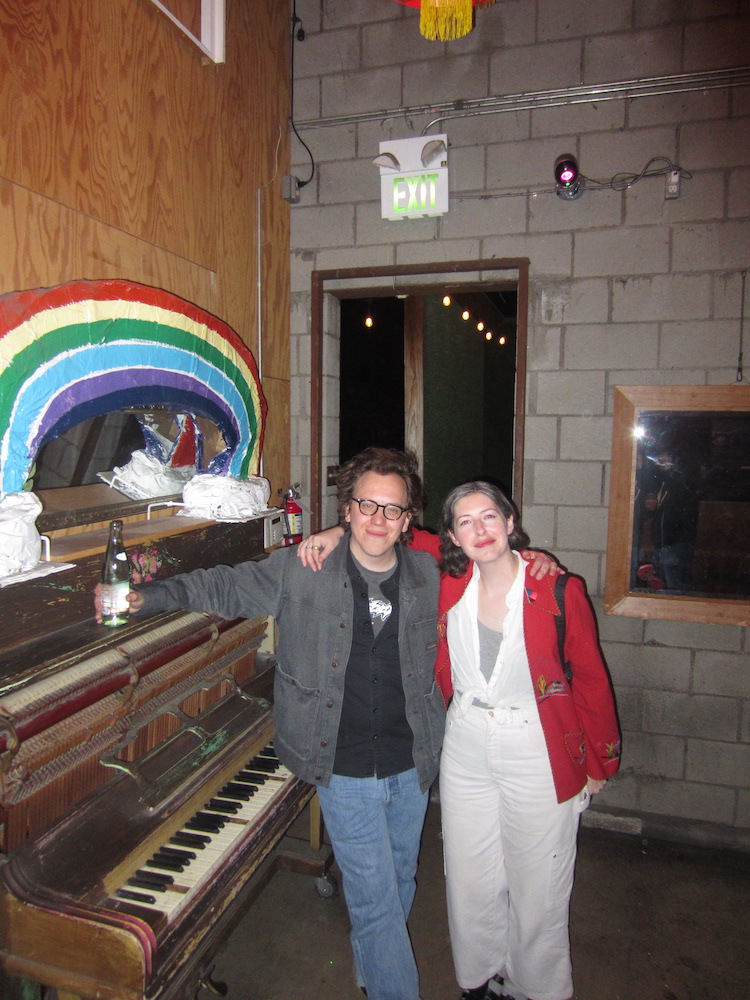
Writer Ben Petrie and production designer Becca Brooks Morrin.
DAY TWO
Amidst a sea of baseball caps, tote bags, and round-rimmed glasses, Adrian Anderson, writer-director of Pomp & Circumstance (2023), remarked: “40% of people here would take a bullet for Mubi.” It was unmistakable that we were at 2220 Arts + Archives on day 2 of the Los Angeles Festival of Movies. Shuffling between screenings and milling around the lobby, I was struck by how familiar I was with the crowd, as if the same 10 to 15 people were going to each film. People who could comfortably tell you that they’ve seen a Straub-Huillet film but are just as likely to follow up the statement with “I wasn’t really in the right headspace at the time, I’d need to rewatch.” In a city dominated by the entertainment industry, it endlessly fascinates me how caring about independent, experimental, or formally daring films has coagulated into its own specific niche, which festival heads Micah Gottleib and Sarah Winshall have seized upon. Naturally, there did not seem to be any USC or UCLA film students in attendance.
My day started with the US premiere of LA-based artist and filmmaker Courtney Stephens’ Invention. Straying away from her previous documentary work, the film could be described as docu-fiction, following actress Callie Hernandez as she attempts to settle her eccentric, recently deceased father’s estate, deliberating whether or not to inherit the patent to his failed electromagnetic healing device. Despite being a transition into the world of fiction, I still saw parallels to Stephens’ previous features, specifically The American Sector (2020), which captures chunks of the Berlin Wall scattered throughout the US and the lives that surround them. While The American Sector saw the grafting of personal narrative onto a larger historical one, Invention sees the grafting of another, perhaps heavily fictionalized personal narrative onto archival footage. Interspersed throughout the film, we see real footage of Hernandez’s father on various morning shows as a crackpot inventor extolling the virtues of alternative healing—footage that Stephens and Hernandez revealed during the Q&A was taken out of context: he was a doctor and not an inventor. Part of the film’s mystique then becomes parsing through what is real and what is fake. Ultimately, what was authentic were the emotions of Hernandez, who utilized conspiracy as a way to process grief. As much as the film can lay claim to the designation of docu-fiction, it also follows in the footsteps of the very modern and very American innovation of cinematic autofiction, gesturing to those that came before via supporting roles from Joe Swanberg and Caveh Zahedi, whose appearances elicited visible gasps from the audience. However, what really moved me were the transitions between scenes, which captured a flickering candle and a restless body of water, as if to suggest there was a kernel of truth in something as seemingly fictitious and far-flung as vibrational healing.
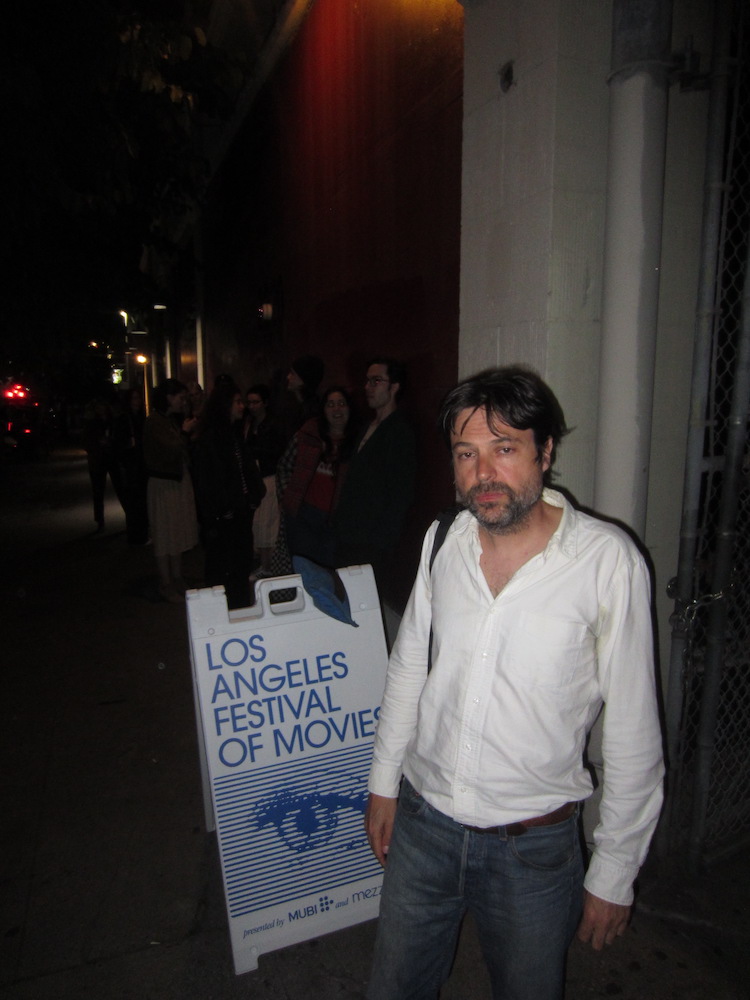
Director Virgil Vernier.
Perhaps my first real discovery during the festival was Virgil Vernier’s Cent Mille Milliards (100,000,000,000,000), which had its West Coast premiere at 2220. The film follows a teenage male escort as he wanders around Monaco, lost in increasingly artificial environments while his body gets passed around by the ultra-rich, and eventually finds refuge during the Christmas season with a Serbian babysitter and a young girl whose parents practically own the country. Throughout the film, a famous Mark Fisher adage rang in my head: “It’s easier to imagine the end of the world than the end of capitalism,” a state that has become somewhat of a mantra for Gen Z, who have inherited a neoliberal world where any desire for actual material change is laughed off as an unrealistic pipe dream. Throughout the film, Vernier’s characters navigate a country that appears as a simulation, constantly destroying and reconstructing itself, as elegantly signified by imposing shots of cranes hanging in the air, fighting to stay afloat, and using their bodies as a means of survival as the only commodity they seem to have ownership of. What adds to the feeling of displacement is that every character appears to be descended from immigrants (at least in the traditional French imagination), a point I raised that Vernier responded quite frankly to, “Nobody lives in Monaco. Monaco is really a place for tourists. You just pass by. You just stay for a while, but nobody was born there, right? Like the old lady said, she can grow old very fast.” Adding to the feeling of impermanence are attempts by his characters to modify their bodies through artificial means of lip fillers and healing stones as if to forcibly impose a sense of change that appears outside of grasp, something Vernier touched on saying, “It’s very LA—the desire to be always young and beautiful, and because you sell your body to make a living. Sex work is about that.” A fascinating wrinkle to the film is how seemingly sex-negative it is, choosing to affirm rather than combat Gen Z’s neurotic fear of sex, with Vernier voicing his displeasure to see depictions of sex on-screen, something he perceives as a way to commodify the act. This notion is echoed through his focus on sex workers, “At the same time, sex is work, but it’s not pleasure, it’s not intimate. It’s just work, just a way of making a living.” When quizzed about whether he views how we engage with sex today with a level of cynicism, Vernier denied the sentiment and instead gave a direct answer, “We have started to realize this was a myth of sex as something liberating.” In the world of Cent Mille Milliards (100,000,000,000,000), which seems to constantly be on the verge of implosion, sexual freedom under capitalism ultimately appears as another pipe dream for Gen Z.
Capping off the night was the West Coast Premiere of Grace Glowicki’s Dead Lover, which Sarah Winshall described as “the closest thing LAFM had to a midnight movie.” Taking place on various black box soundstages and performed by four actors armed with various wigs and funny accents, Dead Lover is a raucous comedy following a gravedigger who resorts to the supernatural to revive her recently deceased paramour. Stuffed to the brim with gags—speed ramping, Tex Avery sound effects, prosthetics fingers, and the like—Dead Lover elicited the biggest reaction from the crowd, who yelped and squirmed in equal measure. The arrival of the film onto US soil via LAFM, as well as Sundance, signifies a formal coronation of the current Canadian independent scene colloquially named “The New Toronto Bizarre,” a term Dead Lover actor and co-writer Ben Petrie sheepishly acknowledged, remarking “I embrace my brothers and sisters often and passionately.” In recent months, Canadian indie exports have stuffed the screens of microcinemas throughout LA, becoming the fascination of the chronically online cinephile class with films from Nate Wilson’s The All Golden (2023) to Braden Sitter Sr.’s The Pee Pee Poo Poo Man (2024) to Petrie’s own The Heirloom (2024) which has a screening booked in the near future. When asked about what seems to be in the air up north, Petrie responded, “I would say that our country’s cinema is pretty bad when it’s trying to imitate America. It’s at its best when we embrace our position as a sideshow and play in that space. I think that the freedom of doing our own thing and not trying to be ‘Hollywood of the North’ creates the best work.”
While having a captive Canadian audience, I was able to air out something that has been plaguing me for the past few months: there’s a Canadian sound designer also named Matt Chan who keeps getting “Special Thanks” credits in these films, including Dead Lover. There are only so many times I can get a DM from someone saying that they spotted my name in the credits of Matt and Mara (2024), only for me to reply that I’ve never met Kazik Radwanski, Deragh Campbell, or Matt Johnson in my life, nor stepped foot in the beautiful city of Toronto. I was told that Canadian Matt Chan is “the best sound mixer in Toronto,” “the bomb,” and “the best.” For the sake of IMDb credit, I suggest one of us change our name. I can be “Matthew A. Chan”, taking after my actual middle name, “Augustus,” which I usually show off on my ID as a party trick, much to the bemusement of others, and maybe he can be “Matthew B.”
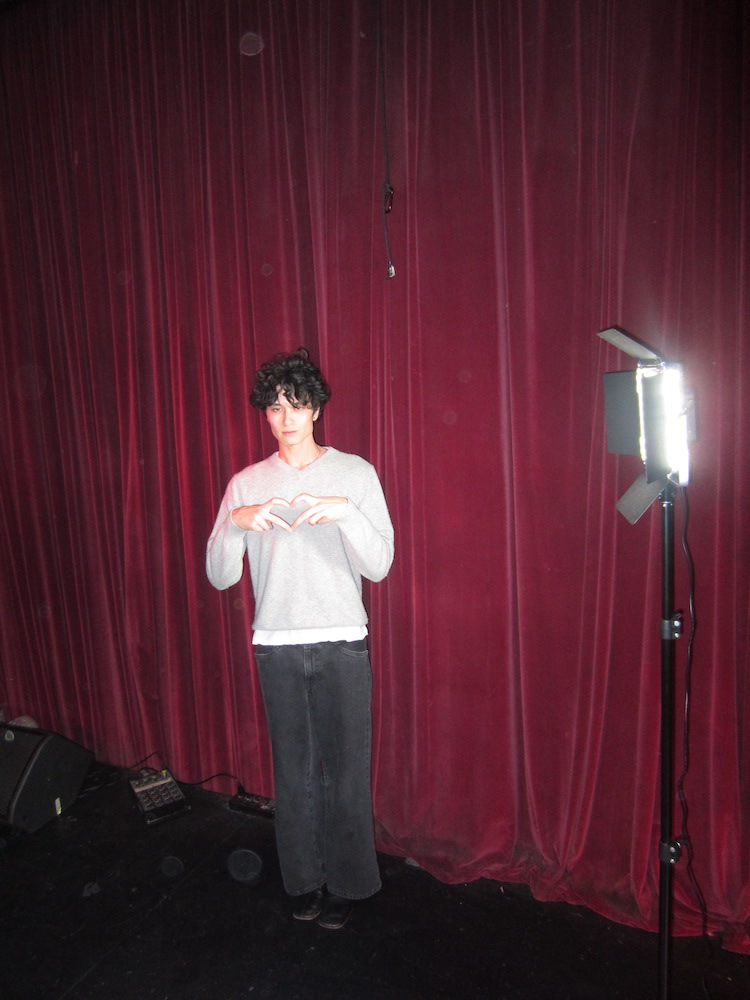
Julian Castronovo.
DAY THREE
Throughout day three of the Los Angeles Festival of Movies, whenever I told someone I wrote for Artillery, I followed it up by saying that if they told me something really funny it would end up in the article. But nothing made my ears perk up quite like a statement from Max, a gaffer on Dennis Cooper and Zac Farley’s Room Temperature, which had its world premiere last night. When asked if he liked the movie, Max said he couldn’t really watch movies anymore and that instead of working on movies, he wished he could spend his time setting up gigantic art installations with beautiful LED screens, projects which could, unfortunately, not gain any funding. His comment made me consider how many people trying to hack it out in independent film today (an industry seemingly in the state of decline) are merely stragglers from the world of fine art (also in decline) looking for something to do. However, an extended chat with festival co-founder, head programmer, and Mezzanine head honcho Micah Gottlieb revealed a much more charitable estimation regarding the handful of fine artists-turned-filmmakers in this year’s lineup.
My initial question to Gottlieb was if he was consciously looking to program films that captured a texture of modernity that felt absent in most contemporary cinema. His reply was that the selection process was more intuitive and that “One thing that I’m really attracted to is artists who are people who are—I mean, okay, yeah, sure, everyone’s an artist—but people who are coming to cinema from the arts, rather than from a film school background. I’m not saying that those movies are automatically good or interesting, but I think that in the case of Amalia and in the case of Julian Castronovo—who went to CalArts—you have these films that are more informed by theory, contemporary art, and personal practice. I’m excited by movies that feel like they’re taking the risks and trying new things out.”
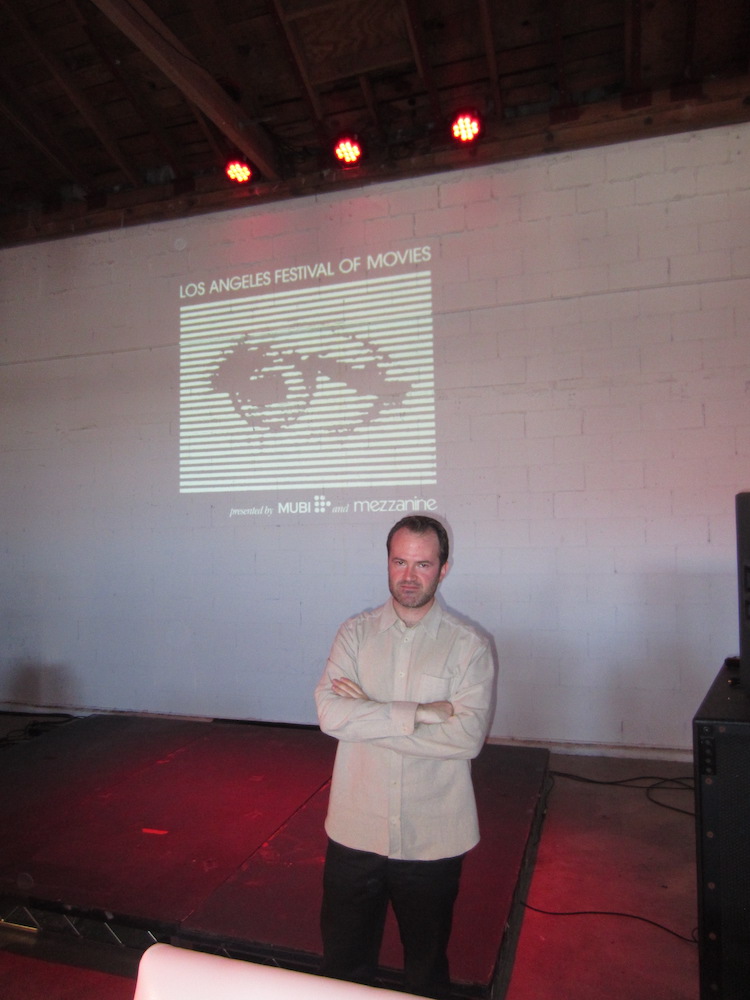
Micah Gottlieb.
Castronovo’s film, Debut, or, Objects of the Field of Debris as Currently Catalogued, which had its West Coast premiere at 2220 Arts + Archives, was, as advertised, a work that defied easy categorization. The film follows Castronovo himself as he traces his life from art school burnout to would-be detective and filmmaker. We see Castronovo unraveling a mystery of art forgery that starts from a postcard of a painting of a fawn and a copy of Don Quixote found in his walls before moving through a world of Chinese diasporic forgers, fake Mubi business cards, and ill-fated trips to Prague. Formally, the film could be described as an essay-film akin to Orson Welles’ F for Fake (1973), as it uses a fictitious documentary style to expose a similar world of art forgery, deception, and the artifice inherent to the cinematic medium. At times, Castronovo’s film—which features no footage from professional cameras, instead remixing MacBook Photobooth sessions, screen recordings, scanned images, and archival DV footage—resembles an elevated Screenlife film. The nascent film form was pioneered by Timur Bekmambetov (director of Abraham Lincoln: Vampire Hunter) and places all of the action on a desktop, something now echoed in iconic films like Unfriended (2014), Unfriended: Dark Web (2018), and Searching (2018). Most of Debut occurs superimposed over the black wallpaper of Castronovo’s laptop screen as the mystery unravels through browser tabs and hyperlinks—a curious example of how aesthetics typically considered lowbrow and “cringe” (Unfriended being known to produce scathing reaction videos from YouTubers intended to entertain pompous 14-year-olds) can converge with the seemingly contradictory avant-garde ambitions of the art world. In my mind, you can define, to some extent, the era a film was made in by how it formally replicates the effect of a drug popular at the time: the frenetic pace of Martin Scorsese’s After Hours (1985) akin to cocaine, the sluggish half-hearted haze of Abel Ferrara’s The Driller Killer (1979) akin to heroin. With Debut, Castronovo truly stakes his claim as a Gen Z filmmaker by making what is perhaps the first Ritalin film, one which replicates the experience of going on endless online deep dives while on ADHD stimulants. When asked if the film would have been possible without the pharmaceutical industry, Castronovo replied, “No,” and when asked how much Ritalin he did while making it, he likewise curtly replied, “A lot.” What comes with said deep dives is a voracious appetite for reference points concocted via Google search, which Castronovo directly presents by drawing comparisons to Raymond Chandler, Jorge Luis Borges, Michael Snow’s So Is This (1982), and Hollis Frampton’s Hapax Legomena I: Nostalgia (1971). When asked about the film’s conspicuous display of influences, Castronovo answered, “I mean, the conceit of the film is to copy everybody until you’re not copying anymore.” Castronovo’s highly individualistic approach to filmmaking, writing, directing, and editing the film himself with very little outside help, is, in his eyes, an attempt to render the act more akin to a studio practice rather than the stressful, overstuffed, and overstaffed sets emblematic of film school productions. Through his practice, he seeks to address “the paradox of authorship, where you feel as though the process of authoring something is the same process as becoming a person, but it’s also the same process of disappearing as a person or unbecoming.” In an era where it feels increasingly difficult to do anything that hasn’t been done before, it is refreshing to see someone surrender to the excess and, though buried and suffocating under piles and piles of references, be a distinct cinematic voice.
Concerns about the dysfunctional relationship Gen Z has with contemporary cinema tend to rattle in my head, and I bemoaned to Gottlieb that when I moved to LA three years ago to attend film school, I was dismayed to discover my peers’ lack of interest in any work outside the mainstream. It was easy to talk about Michael Mann, but once I brought up Chantal Akerman the well dried up save for two or three other people. Because of this, the programming of Mezzanine and LAFM has become somewhat of a balm for me and people like my friend Coleman Weimer, a USC film production graduate student who sees going to these screenings as akin to taking his medicine: at the very least it provides a space where caring about the thing you care about doesn’t feel insane. Naturally, questions of Gottlieb turned to how the wider public could be swayed to leave the house to take a chance on seemingly inaccessible arthouse films, with the answer boiling down to “context, curation, literacy.” As Gottlieb detailed all the ways to ensnare a younger audience— through building a social media following, taking on non-film world guest programmers a la Rachel Kushner, providing third spaces to interact in a post-Covid world and so on—I was once again confronted with the depressing realization that film as a medium has greatly lost its relevance to the public, especially requires jumping through so many hoops just for someone to take a chance on something new. Though, as evidenced by the hefty box office haul Jared Hess’ A Minecraft Movie made within the past three days of the festival, the theatrical experience is not quite in complete decline, as Gottlieb remarked to me, to whatever extent, “Everyone loves movies.”
One of the most insightful comments Gottlieb made was regarding the original goal of Mezzanine, which was to bridge the gap between the thriving fine art scene in LA and the world of film, which seem to rarely intersect. Because most of today’s formal innovations in cinema seem to trickle down from the art world, the separation between the two always feels arbitrary. But nowadays, it feels like both industries are becoming increasingly cloistered off, catering to the whims of the few who still seek out some sort of aesthetic edification outside their homes. Though as much as I can complain, try as I may, I could not deny the sensorial bliss I felt while watching the West Coast premiere of the restoration of Robina Rose’s Nightshift (1981): a recently rediscovered British proto-slow cinema film that follows a hotel receptionist and the guests that wander in and out of her lobby. Astoundingly, the film predates both Chantal Akerman’s Toute une nuit (1982), which similarly features the constant entrance and exit of bodies as they melt into the night, and Tsai Ming-liang’s Goodbye Dragon Inn (2001), which share a focus on capturing the physical labor involved within the upkeep of public spaces. Suffused throughout the film is a wonderful levity and a lack of care for realism akin to Derek Jarman and Peter Greenaway. While watching a sequence that cycles through the inhabitants of the hotel—an elderly man in pitch darkness front lit by a television screen and a group of women having a pillow fight, feathers fluttering through the air, filling the frame in slow motion—I wondered why anyone would want to deny themselves these aesthetic experiences.

Zac Farley and Dennis Cooper.
It felt ap then that, in keeping with the theme of film industry outsiders, the day ended with the world premiere of Dennis Cooper and Zac Farley’s Room Temperature. Neither Cooper, the writer of such novels as The Sluts (2004) and cult hero of the Los Angeles alt-lit reading elite, nor Farley, a visual artist, come from a traditional film background. Room Temperature is Cooper and Farley’s third collaboration after the anthology Like Cattle Towards Glow (2015) and the French-language Permanent Green Light (2018). The film follows the exploits of a family living in the deserts of California, who turn their eerie, prefabricated home into a haunted house. As they move deeper into the realm of simulacra, radically recontextualizing the space they inhabit, the macabre and the mundane seem to blend through various emotionally detached acts of violence. Farley gave a comparably clear-minded explanation for their fascination with sterile, modern homes, citing the discomfiting lack of decor as being able to “completely focus the film’s attention and the camera’s attention on the characters,” citing “one shot in the film that we call ‘the cake shot,’ because, until the characters walk into the frame, if you sort of tilt your head, it can look like the most beautiful kind of postmodern wedding cake.” The film’s lack of conspicuous visual embellishment comes in hand with Cooper’s desire to be “kind of transparent,” and present a “very focused and very controlled and designed world.” The delicate and at times shocking balance of tones captured within Room Temperature comes encapsulated in the conceptual contradiction of the home haunt, which Farley sees as “very crafted, beautiful things” that also has an “excessive violence, gory and, horror film-like quality.” Adding, “When you go to a home haunt, you can be in the hell room, and then suddenly it’s like Alice in Wonderland. There’s a lot more freedom in some of these spaces. The toolbox is infinite.”
The home haunt in Room Temperature is the perfect vessel to house the multitude of personalities Cooper and Farley have collected by casting various artists, each with their own personal practice, as different family members. In a way, their approach to performance in this film directly works against the flat Bressonian style of Permanent Green Light, allowing for abrupt shifts in emotional affect. In Cooper’s estimation, “As long as the, the tone and the context is really controlled, very neutral, and very empty, you can allow the performances to happen in a more flagrant, more theatrical way. But the context kind of squeezes them so they never become silly, or overwrought.” With their troupe of non-professional actors, Cooper witnessed how they “had to construct these emotions and construct these things in a way that felt really real—really real to them—so that it felt very sincere.” In the artificial space of Room Temperature’s haunted house, it can be hard to discern the real. The magic of the film comes from tumbling through the rooms of Cooper and Farley’s creation, which defy any neat cinematic logic, positioning the absurd and grotesque as inexorable features of the everyday.
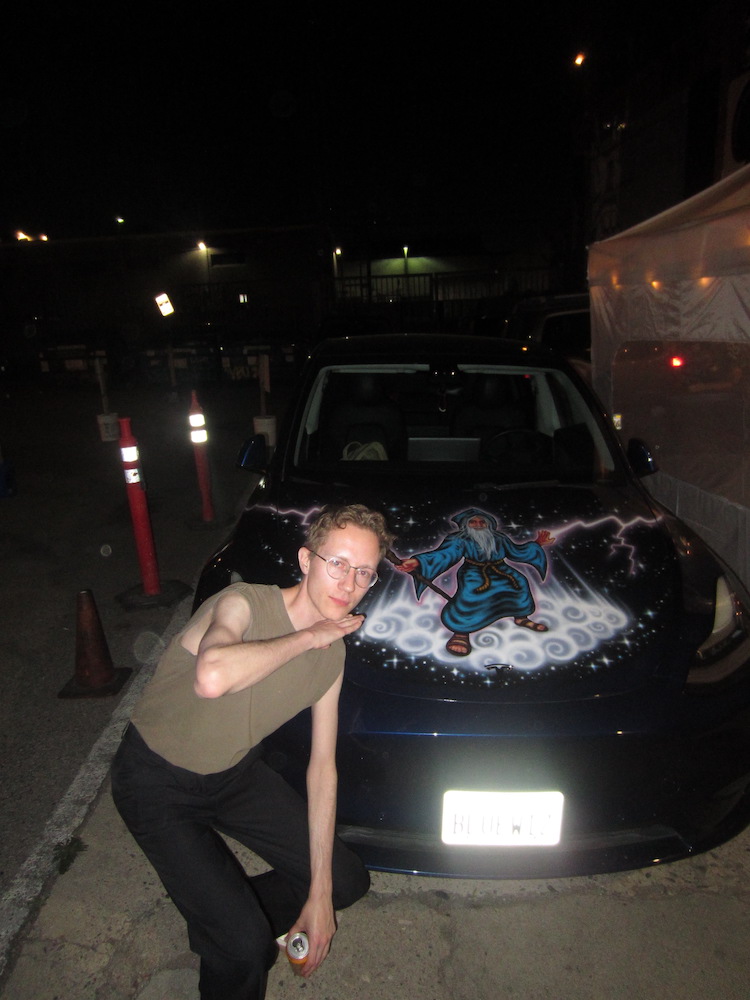
Charlie Shackleton.
DAY FOUR
Whenever approaching someone at the festival, my go-to icebreaker would be, “What is the worst and best part about being indie in LA?” a question that I quickly realized did not apply to everyone but usually elicited similar answers. The best among them was from Tyler Taormina, head of LA-based film collective Omnes Films, director of Christmas Eve at Miller’s Point (2024), and producer of Alexandra Simpson’s No Sleep Till, which had its US premiere yesterday at 2220. He answered, “What I love, of course, is being in a place where all my closest friends are and collaborating with them on films. As well as seeing films in the best theaters in the world. What I don’t like is how expensive it is—how a croissant is $5.” The conflicting desire for creative freedom and financial stability seemed to be a recurring anxiety amongst everyone I talked to, even if we all momentarily inhabited this bubble where independent film felt like the most important thing in the world. A bubble that would inevitably burst as the festival drew to a close on Sunday, with many in the crowd likely clocking into their day jobs at vertical Instagram reel content farms the next morning. This sentiment was echoed by Sarah Winshall, co-founder of the festival and head of production company Smudge Films—which has produced works like I Saw the TV Glow (2024) and Good One (2024)—who said, “The best part of being indie in LA is that I don’t have to commute across town to go work in a studio office. The worst part is that it’s really hard to get paid to do your job.”
My conversation with Winshall, who in the eyes of a precocious film student is someone doing meaningful, successful work, tended to focus on the current precarity of the film business where even hitting traditional barometers of success doesn’t always translate to a living wage. When asked the big question of where everything is headed, Winshall answered, “I think the future of it, at least for me, is that we’re going to be forced to treat film like an art form. Because indie cinema that’s personal and vital is not commercial. There was a time when it was, mostly a long time ago, and there was a slow tapering off and now a real drop-off for that to be something viable. It’s a rare exception that an art piece that is personal is also part of a commercial American film. It’s going to be less and less a job and more and more passion, art, and art practice.”
This positioning of independent film as personal practice was also suggested by Julian Castronovo the day before in his film Debut, or, Objects of the Field of Debris as Currently Catalogued. It further rang in the back of my head while watching Charlie Shackleton’s Zodiac Killer Project, which had its West Coast premiere after making a splash at Sundance. The film follows Shackleton’s attempt to adapt Lyndon E. Lafferty’s book The Zodiac Killer Cover-Up: The Silenced Badge into a true crime documentary, a process that implodes, leaving Shackleton to resuscitate the pieces by feverishly describing what would have happened in his film over shots of locations booked for the would-be shoot. Shackleton is best known for his film Paint Drying (2016), which is perhaps more a conceptual practical joke than an actual film, seeing as it forced the UK censorship board to actually watch 10 hours of paint drying. His punkish spirit continues to shine through in Zodiac Killer Project. For most of the film, Shackleton stays committed to a metatextual skewering of the tropes of true crime, oftentimes by directly showing us clips from Netflix documentaries and making comments on their aesthetic homogeneity. What struck me about the film was how much it hinged on the charms of Shackleton himself, with his constant monologue dictating the flow of footage dispensed to the viewer. When asked if he was mindful about projecting a persona, Shackleton answered, “I would say it’s no more of a persona than when you’re in a bar telling a story to your friends. It’s a rehearsed story, but I quite consciously chose not to script any of it. Because I knew I’m not a good enough actor to perform written words convincingly.” In terms of form, Shackleton’s film feels particularly well-suited to the current age, where we tend to be as interested, if not more, in people than the work they create, developing parasocial relationships with Instagram accounts. It is this same sentiment that fuels the current psychotic cultural fixation with podcasts and streamers—who can somehow sway elections—and Shackleton very astutely mixes both true crime and TrueAnon within the cinematic medium. However, that’s not to say his work is without precedent. I was reminded of both Caveh Zahedi’s The Show About the Show (2017), in the manner in which every moment is a process of describing the making of the work you’re watching, and the audio-visual detachment of the films of Marguerite Duras, whose Le Camion (1977) revealed itself to be a similar object of fixation between me and Shackleton. Unsurprisingly, Zahedi and Duras are both artists known just as much for their public personas as their work. What Zodiac Killer Project actually reminded me of was Pomp&Clout’s music video for one of the best Young Thug songs, “Wyclef Jean,” which features constant running commentary explaining how incredible the video would have been if Young Thug actually showed up for the shoot. When told about this observation, Shackleton replied, “That’s a flattering comparison.”
After various instances of lobby loitering, hitched car rides, and alleyway lurking, and after seeing every new work in the lineup, I tended to express my shock (to whoever was around to listen) at how much I enjoyed every film—a rarity at any festival. I wouldn’t chalk this up to a perfect alignment of taste with Winshall and Micah Gottlieb or festival inflation—which I realized I am mostly immune to, having been surrounded by disgruntled faces at last year’s Cannes after I told them Emilia Perez (2024) was bad immediately post-screening. It was because every film felt like it was attempting something new and occasionally something consciously alienating. However, my positive bewilderment was partially tempered by the realization that most of these films would not easily sell to wide audiences or distributors. A notion Winshall articulated in a more level-headed manner, saying, “I’ve been really noticing lately is that there’s no dearth of movies being made. That’s not an issue. We’re living in a time of just a wealth of movies and good movies being made all the time. The thing that’s tough is finding a way to get them seen and to get people excited about them. For me, as a film producer, sometimes it feels a little irresponsible to be contributing to this big pile of movies that need a place to go. Maybe I’m just easing that guilt by providing us with a place to put our films.”
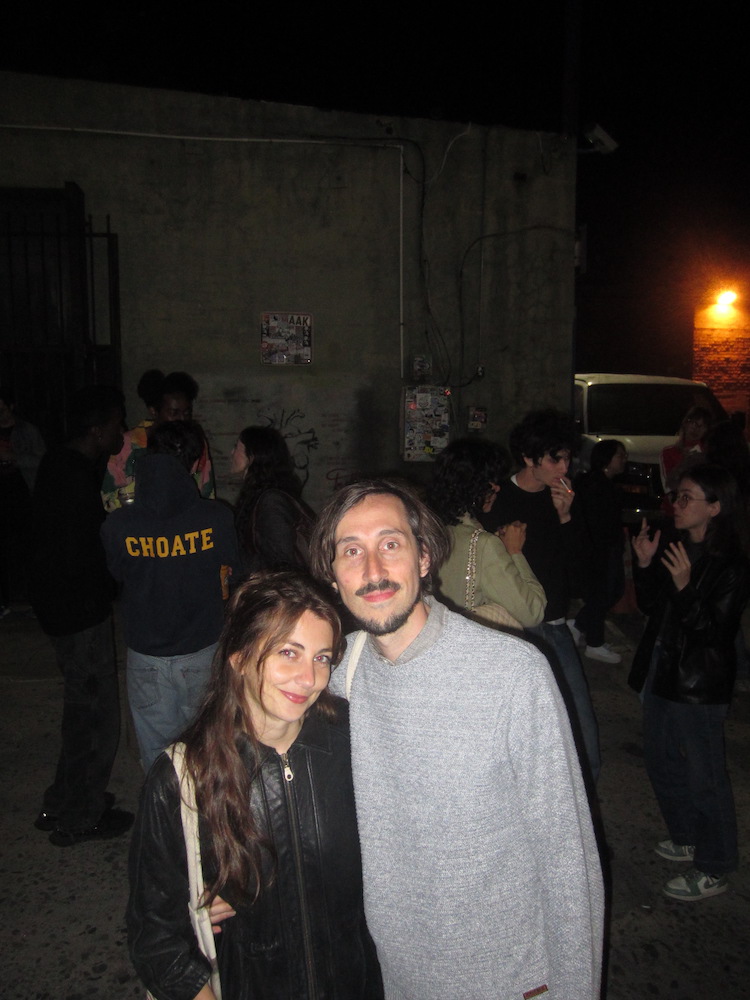
Alexandra Simpson and Tyler Taormina.
The ability to transition from niche, hyper-limited appeal to the still niche but far less limited world of major film festivals and arthouse theatres across the country is something I’ve admired about the films being produced at the LA-based collective Omnes Films, who premiered both Christmas Eve at Miller’s Point and Eephus (2024) at Director’s Fortnight at last year’s Cannes. Both films went on to have fruitful domestic runs. What impresses me about their work is how they’ve managed to produce films that consciously draw from the slow cinema world of filmmakers like Apichatpong Weerasethakul and Chantal Akerman, rendering their chosen locations in vivid ethnographic detail while still retaining the offbeat comedic charm of the American indies of Hal Hartley and Richard Linklater. The film they presented at the festival, which had its US premiere yesterday, was Alexandra Simpson’s feature debut No Sleep Till, which captures the lives of the various residents of a coastal Floridian town who each find ways to cope with an emergency evacuation order triggered by an impending storm. The film weaves between their perspectives as they navigate Florida’s landscapes, which themselves become abstract smears of light and color. With much respect to Tyler Taormina, Carson Lund, and Jonathan Davies, I found Simpson’s picture to be my favorite Omnes Film thus far. Constructed from the Paris-born Simpson’s memories of summers spent in Florida, the film uses the lens of nostalgia to refract the collective’s fixation with texture and detail. Most images in the film seem to be delivered via an intermediary source: captured through the side mirror of a car, reflected and distorted through bodies of water, or replayed through laptop screens, which imbue the town with hazy, impressionistic, and inexact qualities. The focus on immateriality was further echoed by a comment Simpson made in the Q&A, stating that the film did not start with an image but “started with the sound of thunder, which is constant, and these warnings that you really do get, too, because I have been there during pending hurricanes. There’s a sort of electricity in the air that is contagious, and everybody’s sort of put together through this experience, this weight. It’s all tinted with sound because the news is always somewhere in a bar or in people’s homes.” In the shadow of impending doom, Simpson mainly foregrounds tender emotions in a sincere register that never feels maudlin: of two male friends navigating a move out of Florida with the implicit fear of losing one another, or of the first fruits of adolescent love delivered via handwritten notes. It is impressive how much character work is done in a film with so little dialogue or attention on any one individual. The film’s best sequence is abstract: the camera lingers on the shadows of partygoers intermingled with colored strobes, their bodies swaying to ML Buch’s “High speed calm air tonight.”
It always feels revelatory when confronted by a fresh cinematic voice working in an uncommon register like Simpson. It’s also always frustrating to think of the many distinct filmmakers throughout the country dissuaded from a career in film because of its supposed economic instability and lack of funding. Winshall gave a very direct response when asked about this: “You’re not making a living by trying to pursue this. Maybe the answer is the gig economy. Maybe the answer is that you also use your skills to make wedding videos. I don’t know. It sounds depressing to us because we were told that we’re supposed to pursue our passion as a career, and I wish that were something that I could say could happen. That being said, I don’t think that’s possible right now for most people. I know a lot of people who have put their lives on hold, waiting until the moment when their passion is going to become their career in a successful way. I wish that they would just go make stuff.” When I inquired about what Winshall thought fresh film school graduates should be doing, she quickly replied, “Watching movies.” It sounds obvious, but as anyone in film school right now who actually watches movies knows, it’s something startlingly rare amongst their peers.
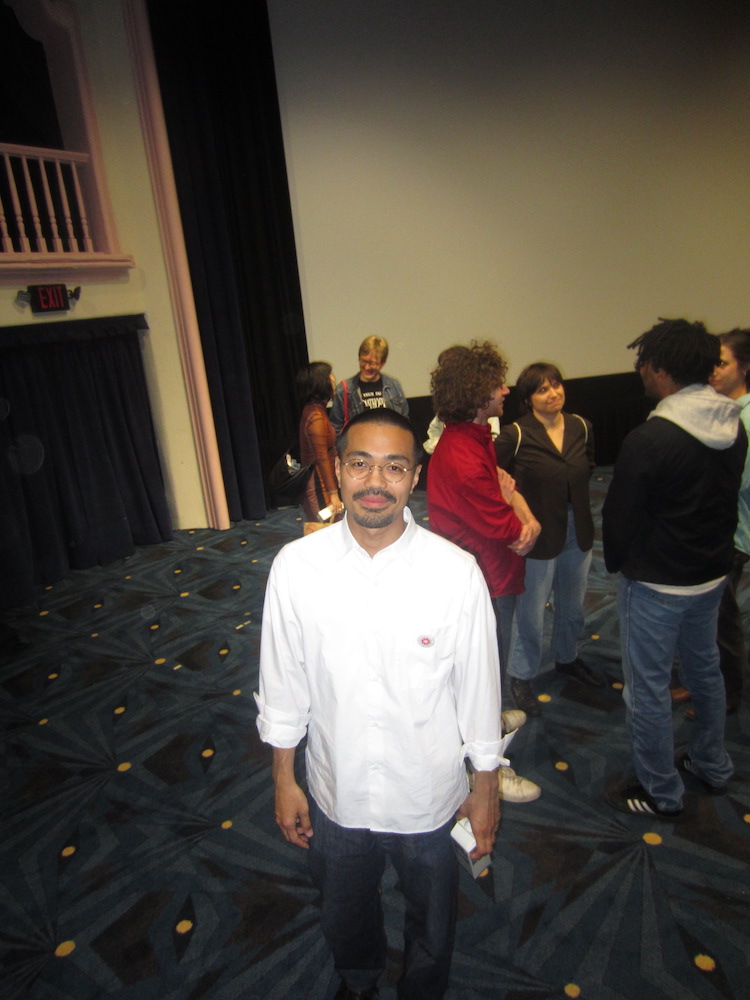
Neo Sora.
It was fitting then that the festival came to a close at Vidiots with the West Coast premiere of Neo Sora’s Happyend, which had its world premiere at last year’s Venice Film Festival and captured many of the latent anxieties regarding the future I’ve endlessly rambled on about—even if the film admittedly felt more like typical festival fare than the various oddities that littered the past 4 days. Sora’s debut narrative feature is set in a near-future Japan headed towards fascist rule as more and more civil liberties are suspended under the pretense of earthquake safety measures. The film follows four students whose high school transforms into a microcosm of Japanese society as a new surveillance system named “Panopty” that monitors their every move is installed. What follows is an eruption of protests as the students are confronted with various hard choices and the question of whether it is right to remain silent in the face of a categorically unjust society. Sora’s film is one that attempts to achieve the epic, emotional scope of other modern coming-of-age classics, such as Edward Yang’s A Brighter Summer Day (1991), which he noted as an influence, and Kenneth Longergan’s Margaret (2011), which position young people as those caught within the throes of history which they remain powerless to change. Though by working so tightly within the manicured aesthetics of current highbrow Japanese cinema—clean digital cinematography and tastefully modern apartments, which many have referred to as “Uniqlo-core”—the film almost feels frictionless in spite of the radical political ideas it attempts to convey. Perhaps one can view the film as working within the conceptual and aesthetic framework of neoliberalism, where every conflict is implicit, with acts of racial profiling conducted on the character of Kou (a Zainichi Korean) being delivered via regimented, bureaucratic policy. There is never any actual violence, only microaggressions and state-mandated checks. The overwhelming politeness of the work did make me yearn for the, at times, ill-conceived angst of a film like Shunji Iwai’s All About Lily Chou-Chou (2001), which similarly tackled growing tech anxiety within Japan. However, I was quick to realize that the film probably resonated with the mostly millennial audience because of the lack of conflict. As Sora reminisced in the Q&A about his involvement in Occupy Wall Street, I wondered how many of the millennials in attendance had a similar experience of being starry-eyed, believing they were doing something actionable for a cause that in reality, did very little to move any needle, realizing how powerless they were in the face of neoliberal hegemony.
Where the film does find resonance is in its parallels to the college encampments that occurred across the country last year in protest of Israel’s occupation of Palestine, which called for schools to divest from funding the State of Israel. Viewing the students of Happyend stage a sit-in in their principal’s office, and despite being shot years earlier, there was an eerie sense of familiarity, one that suggests the historical continuity between student protests. When asked about the parallels, Sora noted, “Basically, what Japan was doing to Korea and these other East Asian countries is what Israel is doing to Palestine right now. There’s a really significant connection between those two things. More and more every day, I can’t believe anyone can be indifferent to what’s going on.” When I inquired as to how he managed to write a film that didn’t fall into complete despair despite taking place in a world where any positive changes seemed impossible, he answered: “You need some degree of hope even to survive, and the fact of the matter is that Palestinians still have hope. I mean, they’re losing it every day. They still have hope that it can stop and they can be free. And if they can have it, then I need to keep it. That’s not necessarily the feeling I had when I wrote the film because I didn’t know anything about Palestine back then, but more and more, I feel that way. I feel like hoping for something new, even in my artistic sense, is also a hope. You need that hope for human ingenuity and creativity so you can believe that there will be a future.”
I don’t think much else needs to be said.

